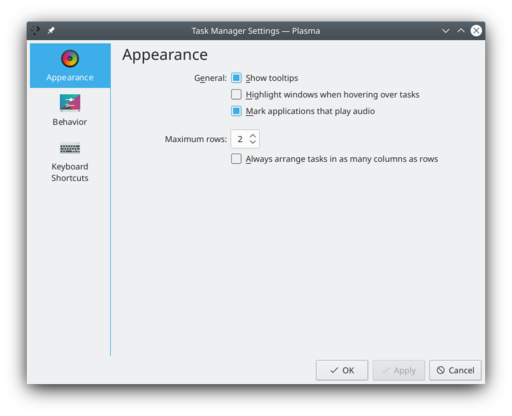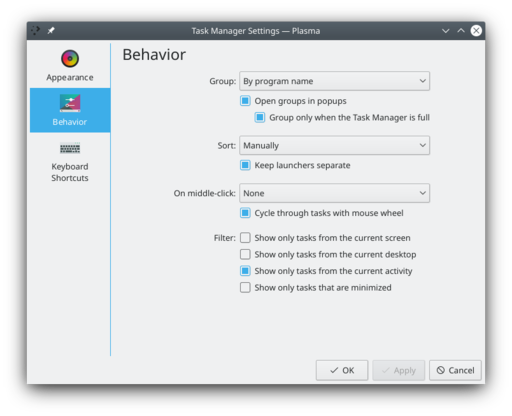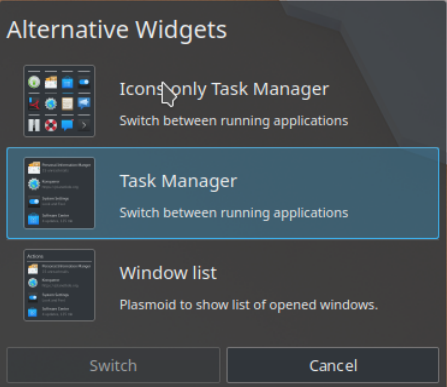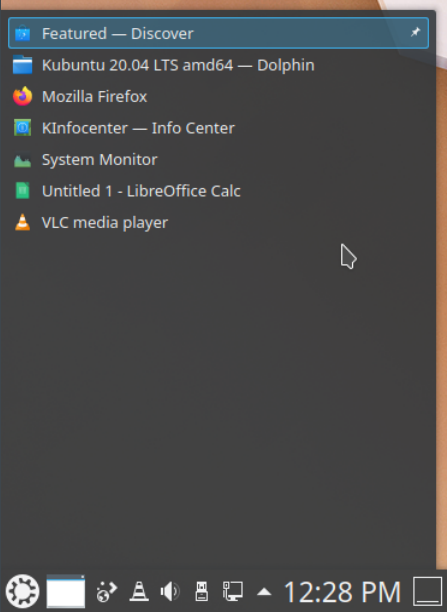Plasma/Tasks/ru: Difference between revisions
Aspotashev (talk | contribs) Created page with "=== Виджет панели задач ===" |
Updating to match new version of source page |
||
| (5 intermediate revisions by 3 users not shown) | |||
| Line 2: | Line 2: | ||
== Панель задач Plasma == | == Панель задач Plasma == | ||
<div class="mw-translate-fuzzy"> | |||
[[Image:Task-manager-in-panel.png|thumb|512px|center|Виджет панели задач, показывающий три приложения.]] | [[Image:Task-manager-in-panel.png|thumb|512px|center|Виджет панели задач, показывающий три приложения.]] | ||
</div> | |||
'''Панель задач''' предоставляет простой доступ к выполняющимся приложениям. Обычно этот виджет находится посередине панели. Если окно одного из приложений закрыто другими окнами или свёрнуто, его можно открыть, щёлкнув на соответствующем элементе на '''панели задач'''. | '''Панель задач''' предоставляет простой доступ к выполняющимся приложениям. Обычно этот виджет находится посередине панели. Если окно одного из приложений закрыто другими окнами или свёрнуто, его можно открыть, щёлкнув на соответствующем элементе на '''панели задач'''. | ||
| Line 8: | Line 10: | ||
=== Виджет панели задач === | === Виджет панели задач === | ||
'''Панель задач''' является виджетом Plasma, поэтому её можно расположить в любом месте рабочего стола или на любой панели. Например, можно создать новую панель вверху экрана и добавить на неё '''панель задач''', либо разместить панель задач на рабочем столе. Можно даже иметь несколько панелей задач в разных местах. | |||
Whenever you start an application you will see a new tab in the '''Task Manager''' showing the icon of the application and the title of the window that was opened. | Whenever you start an application you will see a new tab in the '''Task Manager''' showing the icon of the application and the title of the window that was opened. | ||
If you click on the tab corresponding to the active window then that window will be minimized. If there are still windows that have not been minimized then the frontmost of them will become active. If you click on the tab of a minimized window it will be displayed in front of all other windows, and it will become active. If you click on the tab of a window | If you click on the tab corresponding to the active window then that window will be minimized. If there are still windows that have not been minimized then the frontmost of them will become active. If you click on the tab of a minimized window it will be displayed in front of all other windows, and it will become active. If you click on the tab of a window that is displayed behind other windows it will be brought in front of all other windows, and it will become active. | ||
You can also right-click a tab to bring up the context menu. This gives you a number of options. For example, you can set which virtual screens the windows are displayed on, and you can close the window. | You can also right-click a tab to bring up the context menu. This gives you a number of options. For example, you can set which virtual screens the windows are displayed on, and you can close the window. | ||
[[Image:Task-manager-in-panel-grouped.png|thumb| | [[Image:Task-manager-in-panel-grouped.png|thumb|794px|center|Task Manager showing many windows including a group of three Dolphin windows.]] | ||
If you have many windows opened the tabs may be grouped. In that case you will see a number with a small arrow above in the right hand side of the tab. Clicking on such a tab will bring up a list of tabs for individual windows that you can use just like ordinary '''Task Manager''' tabs. Right-clicking a group gives you the option to close all windows in that group. | If you have many windows opened the tabs may be grouped. In that case, you will see a number with a small arrow above in the right-hand side of the tab. Clicking on such a tab will bring up a list of tabs for individual windows that you can use just like ordinary '''Task Manager''' tabs. Right-clicking a group gives you the option to close all windows in that group. | ||
You can also activate windows by holding <keycap>Alt</keycap> down while pressing <keycap>Tab</keycap> one or more times. This way you browse through all windows whether displayed or minimized. | You can also activate windows by holding <keycap>Alt</keycap> down while pressing <keycap>Tab</keycap> one or more times. This way you browse through all windows whether displayed or minimized. | ||
| Line 24: | Line 26: | ||
{{Note|1=Some applications do not open a GUI when started. Therefore they will not show up in the Task Manager. Instead they have an icon in the [[Special:myLanguage/Plasma/SystemTray|System Tray]].}} | {{Note|1=Some applications do not open a GUI when started. Therefore they will not show up in the Task Manager. Instead they have an icon in the [[Special:myLanguage/Plasma/SystemTray|System Tray]].}} | ||
== Configuration == | === Configuration === | ||
To access the '''Task Manager''' settings menu, right-click on it and click <menuchoice>Task Manager Settings</menuchoice>. If you have | To access the '''Task Manager''' settings menu, right-click on it and click <menuchoice>Task Manager Settings</menuchoice>. If you have trouble clicking on it and not in one of its tasks, you can first click the panel toolbox, so wherever you click on the '''Task Manager''' will work. | ||
[[ | [[File:Task-manager-settings.png|thumb|512px|center|Configuration dialog for Task Manager - Appearance.]] | ||
[[File:Task-manager-settings1.png|thumb|512px|center|Configuration dialog for Task Manager - Behavior.]] | |||
There you can change its behavior. The following settings are particularly useful: | There you can change its behavior. The following settings are particularly useful: | ||
;Grouping and Sorting: | ;Grouping and Sorting: | ||
: | :In the drop down list '''Group''' you can select <menuchoice>By program name</menuchoice> or <menuchoice>Do not group</menuchoice>. (You can also choose to only enable grouping if the taskbar is full.) In the drop down list '''Sort''' you can choose between <menuchoice>Do not sort</menuchoice>, <menuchoice>Manually</menuchoice> (selected by default), <menuchoice>Alphabetically</menuchoice>, <menuchoice>By desktop</menuchoice>, or <menuchoice>By activity</menuchoice>. | ||
;Filters: | |||
:There are several options for not showing all tasks in the tasks manager, but to filter only for those you want to see. | |||
* You may <menuchoice>Show only tasks from the current screen</menuchoice> | |||
* You may <menuchoice>Show only tasks from the current desktop</menuchoice> | |||
* You may <menuchoice>Show only tasks from the current activity</menuchoice> | |||
* You may <menuchoice>Show only tasks that are minimized</menuchoice> | |||
;Have More than One Row on the Taskbar: | ;Have More than One Row on the Taskbar: | ||
:If you use many applications at one time you may find it advantageous to set <menuchoice>Maximum Rows</menuchoice> and then <menuchoice> | :If you use many applications at one time you may find it advantageous to set <menuchoice>Maximum Rows</menuchoice> and then <menuchoice>Always arrange tasks in as many columns as rows</menuchoice>. | ||
;Two useful checkboxes in the <menuchoice>Appearance</menuchoice> section of the <menuchoice>General</menuchoice> page: | |||
*<menuchoice>Showing Tooltips</menuchoice> | |||
Tooltip is a small preview thumbnail of task. | |||
*<menuchoice>Mark applications that play audio</menuchoice> | |||
Applications that play audio are marked with a small loudspeaker symbol, which makes it easier to identify where audio played is coming from. | |||
== Alternative Task Managers == | |||
[[File:task_manager_alternatives.png|thumb|512px|center|List of alternative task managers.]] | |||
You may exchange the standard task manager widget against two other options. To do so, click with the right mouse button on the task manager and choose <menuchoice>Show alternatives</menuchoice> from the context menu. One is the <menuchoice>Icons Only Task Manager</menuchoice> and the other one is the <menuchoice>Window-List</menuchoice>. Let us look at both. | |||
=== Icons only Task Manager === | |||
[[File:task_manager_icons_only.png|thumb|512px|center|That's how the '''Icons only task manager''' looks like.]] | |||
The '''Icons Only Task Manager''' shows tasks only by their icon and not by icon and title of the window opened. This needs less space and there can be more tasks shown. This task manager has, by and large, the same configuration options as the standard task manager. | |||
=== Windows List === | |||
[[File:task_manager_windows_list.png|thumb|512px|center|That's how the '''Windows List''' looks like.]] | |||
With '''Windows List''' the task manager shrinks to only one icon to be displayed. Clicking on this icon opens the list of tasks. This widget has virtually no configuration options. | |||
[[Category:Plasma]] | <div class="mw-translate-fuzzy"> | ||
[[Category:Improve]] | [[Category:Plasma/ru]] | ||
[[Category:Improve]] <--Do not translate--> | |||
</div> | |||
Latest revision as of 11:05, 17 January 2021
Панель задач Plasma
Панель задач предоставляет простой доступ к выполняющимся приложениям. Обычно этот виджет находится посередине панели. Если окно одного из приложений закрыто другими окнами или свёрнуто, его можно открыть, щёлкнув на соответствующем элементе на панели задач.
Виджет панели задач
Панель задач является виджетом Plasma, поэтому её можно расположить в любом месте рабочего стола или на любой панели. Например, можно создать новую панель вверху экрана и добавить на неё панель задач, либо разместить панель задач на рабочем столе. Можно даже иметь несколько панелей задач в разных местах.
Whenever you start an application you will see a new tab in the Task Manager showing the icon of the application and the title of the window that was opened.
If you click on the tab corresponding to the active window then that window will be minimized. If there are still windows that have not been minimized then the frontmost of them will become active. If you click on the tab of a minimized window it will be displayed in front of all other windows, and it will become active. If you click on the tab of a window that is displayed behind other windows it will be brought in front of all other windows, and it will become active.
You can also right-click a tab to bring up the context menu. This gives you a number of options. For example, you can set which virtual screens the windows are displayed on, and you can close the window.

If you have many windows opened the tabs may be grouped. In that case, you will see a number with a small arrow above in the right-hand side of the tab. Clicking on such a tab will bring up a list of tabs for individual windows that you can use just like ordinary Task Manager tabs. Right-clicking a group gives you the option to close all windows in that group.
You can also activate windows by holding Alt down while pressing Tab one or more times. This way you browse through all windows whether displayed or minimized.
Configuration
To access the Task Manager settings menu, right-click on it and click . If you have trouble clicking on it and not in one of its tasks, you can first click the panel toolbox, so wherever you click on the Task Manager will work.


There you can change its behavior. The following settings are particularly useful:
- Grouping and Sorting
- In the drop down list Group you can select or . (You can also choose to only enable grouping if the taskbar is full.) In the drop down list Sort you can choose between , (selected by default), , , or .
- Filters
- There are several options for not showing all tasks in the tasks manager, but to filter only for those you want to see.
- You may
- You may
- You may
- You may
- Have More than One Row on the Taskbar
- If you use many applications at one time you may find it advantageous to set and then .
- Two useful checkboxes in the section of the page
Tooltip is a small preview thumbnail of task.
Applications that play audio are marked with a small loudspeaker symbol, which makes it easier to identify where audio played is coming from.
Alternative Task Managers

You may exchange the standard task manager widget against two other options. To do so, click with the right mouse button on the task manager and choose from the context menu. One is the and the other one is the . Let us look at both.
Icons only Task Manager

The Icons Only Task Manager shows tasks only by their icon and not by icon and title of the window opened. This needs less space and there can be more tasks shown. This task manager has, by and large, the same configuration options as the standard task manager.
Windows List

With Windows List the task manager shrinks to only one icon to be displayed. Clicking on this icon opens the list of tasks. This widget has virtually no configuration options.


